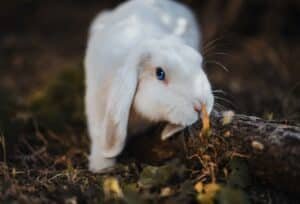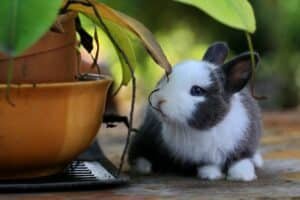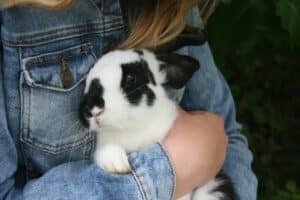Rabbits are complex creatures that require careful attention to their environment to ensure their health and well-being. The ideal temperature for a rabbit is between 60°F and 70°F (15°C and 21°C). Extreme temperatures, both hot and cold, can cause serious health issues for rabbits. In the winter, they need additional warmth provided by shelter and bedding, while in the summer, they require a cool, shaded area to prevent overheating. Changes in the rabbit’s body temperature should be gradual as sudden changes can lead to stress for the rabbit. Regular monitoring of the rabbit’s behavior and physical state can provide valuable cues about their comfort level with the current temperature. The indoor enclosure for the rabbit should be spacious, and comfortable, and maintain a stable temperature within the preferred range.
Understanding Rabbits and Temperature
Rabbits are adapted for temperate climates, meaning that they thrive in mild temperatures. They are well equipped to adjust their body temperature during winter and summer months. Their thick fur also helps them stay warm in the cold and cool during hot weather. However, when temperatures get too high or low, rabbits can suffer from physical stress which can lead to serious health issues such as heat stroke or hypothermia.

Ideal Temperature for Rabbits: A Seasonal Guide
Although the ideal temperature for rabbits is between 60°F and 70°F, they can also tolerate temperatures over a wide range of temperatures.
Spring
As the temperature begins to get warmer temperatures and rise during the spring, it is important to make sure that your rabbit’s environment does not become too hot. The best way to maintain a comfortable temperature for your rabbit during this time of year is to provide them with plenty of shade and air circulation in an outdoor enclosure. If you are housing your rabbit indoors, open windows and use fans to keep the temperature at a comfortable level.
Summer
During summer months, rabbits should always have access to cool air and shade in order to avoid overheating. In an outdoor enclosure, you can provide shade by adding umbrellas or other materials that block direct sunlight from reaching your rabbit. You should also monitor the temperature of their environment regularly to make sure it does not become too hot. If you are housing your rabbit indoors, make sure to keep the room cool by closing windows and using fans or air conditioning when necessary.
Fall
During the winter temperatures and fall season, rabbits should have access to warm shelter and bedding as temperatures begin to drop. It is important to provide them with a suitable environment that will maintain a temperature that is comfortable for them, particularly during the colder months.
Winter
In winter, your rabbits tend to need extra protection from the snow and cold weather. If your rabbit’s enclosure is outdoors, make sure to provide adequate shelter with plenty of bedding material to keep them warm. If you are housing your rabbit indoors, provide plenty of blankets and insulation to keep them warm. You should also monitor the temperature of their environment regularly to make sure it does not become too cold.
The Importance of Temperature Management for Rabbits
It is important to maintain proper temperature management for rabbits in order to keep them healthy and happy. When the temperature becomes too hot or too cold, it can be stressful for your rabbit and can lead to serious health problems. Regular monitoring of their environment is key to maintaining a comfortable temperature that will meet your rabbit’s needs.

Effects of Cold Temperatures on Rabbits
When temperatures become too cold, rabbits can suffer from hypothermia, which is a condition caused by prolonged exposure to low temperatures. Hypothermia in rabbits can lead to symptoms such as shivering, lethargy, and difficulty breathing. To avoid this condition, it is important to provide your rabbit with adequate shelter and bedding during the colder months.
What Happens If A Rabbit Gets Too Cold?
If a rabbit gets too cold, their body temperature will begin to decrease and this can lead to hypothermia. Hypothermia can cause the rabbit to become lethargic, and unable to move due to muscle weakness, and eventually may lead to death. It is important to provide your rabbit with warm shelter and bedding during the winter months in order to avoid this condition.
Cold Weather Tips for Rabbit Care
When caring for rabbits during the cold winter months, it is important to provide them with ample shelter and bedding. Make sure their hutch or enclosure is insulated properly and that they have access to plenty of warm blankets. It is also important to monitor the temperature of their environment regularly to make sure it does not become too cold. Additionally, make sure the rabbit has access to food and water as these are important for keeping them warm.
Effects of Hot Temperatures on Rabbits
When temperatures become too hot, rabbits can suffer from heat stroke, which is a condition caused by prolonged exposure to high temperatures. Heat stroke in rabbits can lead to symptoms such as panting, drooling, and muscle tremors. To avoid this condition, it is important to provide your rabbit with plenty of shade and air circulation during the summer months.
How Heat Affects Your Rabbit’s Health
When exposed to high temperatures, your rabbit can suffer from heat stroke. This condition occurs when their body temperature rises above 104°F and can cause serious health issues such as dehydration, muscle tremors, and even death. To prevent this condition, it is important to monitor the temperature of their environment regularly and make sure they have access to plenty of shade and air circulation.
How to Prevent Overheating in Rabbits
In order to prevent your rabbit from overheating, it is important to provide them with plenty of shade and air circulation during the summer months. If you are housing your rabbit outdoors, make sure their enclosure is well-shaded and that they have access to plenty of water. If you are housing your rabbit indoors, keep windows open and use fans or air conditioning when necessary. Additionally, make sure to monitor the temperature of their environment regularly to make sure it does not become too hot.
Differences between Indoor and Outdoor Rabbit Housing
When it comes to housing a rabbit, there are benefits and drawbacks to both indoor and outdoor enclosures. One of the major differences between these two types of housing is temperature control. While an indoor enclosure can be heated or cooled according to your preference, an outdoor enclosure will be subject to the changing temperatures of its environment.

Pros and Cons of Indoor Housing for Rabbits
Pros
Temperature can be controlled easily with heating/cooling systems
Easier to monitor and protect your rabbit from potential predators
Less exposure to inclement weather such as rain, snow, and wind
Cons
Can be noisy due to the presence of air conditioning or heating systems
Requires more maintenance in the form of regular cleaning and upkeep
Rabbits may become bored due to lack of environmental enrichment
Pros and Cons of Outdoor Housing for Rabbits
Pros
Allows rabbits to experience natural elements such as rain, snow, and wind
More freedom for the rabbits to explore their environment
Natural sunlight can be beneficial for rabbits as it helps to produce Vitamin D
Cons
Temperature variations throughout the year can be difficult to control
Can be difficult to protect your rabbit from potential predators such as cats and hawks
Exposure to inclement weather can lead to health issues if your rabbit is not adequately sheltered.
Recognizing Temperature Distress in Rabbits
How to Tell If a Rabbit Is Too Cold?
If your rabbit is too cold, they may display signs of hypothermia. These symptoms can include shivering, lethargy, and difficulty breathing. If you notice that your rabbit is exhibiting any of these signs, it is important to take immediate action to provide them with warmth and shelter.
How to Tell If a Rabbit Is Too Hot?
If your rabbit is too hot, it may display signs of heat stroke. These symptoms can include panting, drooling, and muscle tremors. If you notice that your rabbit is exhibiting any of these signs of body heat, it is important to take immediate action to provide them with shade and air circulation.
Frequently Asked Questions (FAQs)
How cold is too cold for rabbits?
The optimal temperature range for rabbits is between 50-70°F. Anything colder than this can lead to hypothermia and should be avoided.
What temperature is too hot for rabbits?
The optimal temperature range for rabbits is between 50-70°F. Anything higher than this can lead to heat stroke and should be avoided.
Can rabbits stay outside in winter/summer?
Yes, rabbits can stay outside in both winter and summer as long as their enclosure is properly insulated and they have access to adequate shelter. However, it is important to monitor the temperature of their environment regularly to make sure it does not become too cold or hot.
How to warm up a cold rabbit?
If your rabbit is too cold, it is important to take immediate action to provide them with warmth and shelter. This can include providing them with heated bedding or moving their enclosure indoors. Additionally, you should contact a veterinarian if the rabbit does not seem to be improving.
What should I do if my rabbit has a heat stroke?
If your rabbit is suffering from heat stroke, it is important to take immediate action to provide them with shade and air circulation. This can include moving their enclosure outdoors or providing them with fans/air conditioning units. Additionally, you should contact a veterinarian if the rabbit does not seem to be improving.
Can drastic temperature changes harm rabbits?
Yes, drastic temperature changes can harm rabbits as they may not be accustomed to the sudden shift in temperatures. To prevent this, it is important to monitor the temperature of their environment regularly and adjust accordingly. This can include providing them with heating or cooling systems depending on the season. Additionally, you should contact a veterinarian if the rabbit does not seem to be adjusting to the temperature changes.
What kind of indoor enclosure is suitable for rabbits?
When it comes to housing a rabbit indoors, there are several options available. Depending on the size of your rabbit and the amount of space you have available, you can use wire cages, plastic cages, or even converted furniture pieces such as dressers and bookcases. Additionally, whatever enclosure you choose should provide ample ventilation and room for your rabbit to move around.
How can I make a rabbit hutch ready for winter?
To make a rabbit hutch ready for winter, it is important for rabbit owners to ensure that the enclosure is properly insulated and has access to adequate shelter. This can include providing them with heated bedding or enclosing their hutch in an insulated covering such as a tarp or blanket.
Conclusion
In conclusion, temperature is an important factor to consider when housing rabbits. It is important to monitor the temperature of domestic rabbits in their environment regularly to make sure it does not become too cold or hot. Additionally, if you notice that your rabbit is exhibiting any signs of distress due to temperatures outside of the optimal range, it is important to take immediate action in order to provide them with warmth or shelter. Finally, it is important to make sure the enclosure you choose is properly insulated and provides adequate ventilation in order to protect your rabbit from extreme temperatures.



